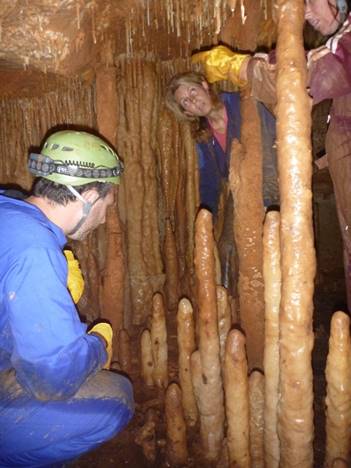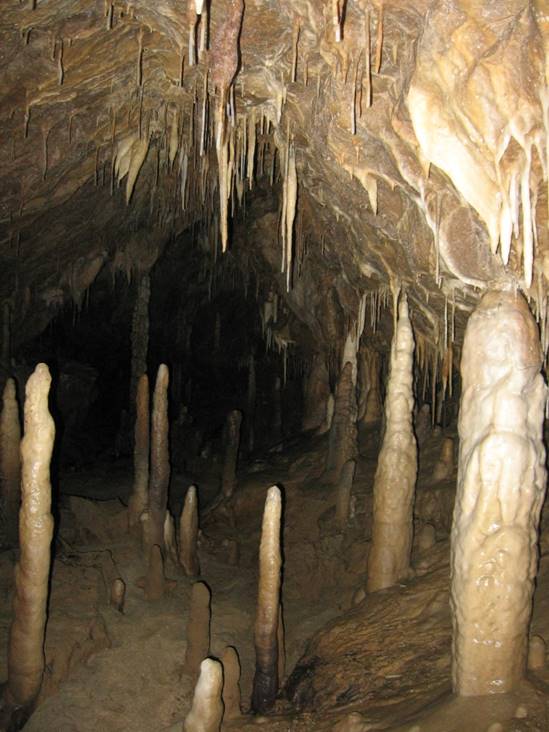Climate Geology
The Climate Geology group studies how the Earth’s climate system has responded in the past to different levels of atmospheric CO2, solar energy, and frequency of volcanic events.
We obtain climate information from stalagmites and microfossils from ocean and lake sediments. These records elucidate how the earth’s climate system works, and better predict the climate response to anthropogenic changes.
How easy is it to melt the Greenland and Northern Hemisphere ice sheets?
The Greenland ice sheet melted back to less than half its current size, around 125,000 years ago. Consequently, sea levels were at least five meters higher than now. We are investigating how changes in solar energy, greenhouse gases, and ocean currents contributed to melt the Greenland and northern hemisphere ice sheets.
We study indicators of climate in stalagmites that grew in caves of northwest Spain throughout the last several hundreds of thousands of years. Each year, rainwater infiltrating into the cave lays down a thin layer of mineral on the stalagmite. We carefully sample these layers and analyse their elemental and isotopic composition. From this we can learn about the size of large ice sheets, the temperature, and amount of rainfall during the time each layer was deposited. By knowing the exact age, we can precisely compare the climate with calculations of how the solar energy changed in different seasons due to slow cyclical changes in the earth’s orbit around the sun.
We can also investigate how the melting of the ice sheets affects the ocean currents in the North Atlantic, which in turn influence climate. Since the Greenland ice sheet may be vulnerable to anthropogenic warming, these results help predict future climate.
How sensitive is earth’s climate to atmospheric CO2?
Tree pollen around Antarctica and records of 26 degree oceans off New Zealand, suggest that earth was much warmer than present 50 million years ago. Then about 33 million years ago, the Antarctic Ice sheet, with ten times more ice than Greenland, grew and expanded out to the coast of Antarctica. Changing levels of atmospheric CO2 are often invoked to explain these changes. But how high was CO2 when Antartica was ice free and covered with coastal forests? What was the critical CO2 level when the Antarctic ice sheet formed? And at what CO2 level has significant meltback occurred? More generally, how sensitive is the earth’s climate to atmospheric CO2 levels?
To answer these questions, we are working to develop better ways to estimate atmospheric CO2 levels in the distant past. Marine algae need CO2 for photosynthesis, and the isotopic composition of organic and mineral fossils they produce can reveal the level of CO2 limitation they experienced. We use the fossils of microscopic algae that accumulate in sediments at the bottom of the ocean. Cores of sediments taken from hundreds of meters below the sea floor allow us to sample and analyse these fossils. Our work so far has revealed a previously undetected CO2 decline accounting for a strong cooling between 10 and 6 million years ago.
The size and shape of the fossils themselves also reveal adaptations to CO2. We use high resolution microscopy with digital cameras to see measure changes in the size and the thickness of the calcite mineral shells that covered the algae. Finally, we are using some known indicators, and working to ground-truth new ones, to infer the ocean temperatures from the tropics to the poles, during these past periods of high CO2.
Our group is not always stuck in the deep marine muds. To better understand how marine algae record CO2 conditions, and at the same time better understand how the algae adapt to changing levels of CO2, we grow marine algae in an experimental growth chamber under different levels of CO2, light, and nutrients.
Climate extremes on the land
The estimation of past temperatures is one of the fundamental goals of palaeoclimate research. We are working to improve the measurement precision and calibration of a widely applicable “palaeothermometer” based on the increased clumping of heavy isotopes 13C and 18O in minerals at low temperatures. With this tool, we are able to estimate how hot summer temperatures were on land 50 million years ago, and how much warming came from ancient cycles in volcanic CO2 release in the era of the dinosaurs.
The Climate Geology group at ETH Zurich is led by Heather Stoll.

